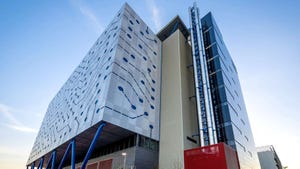
Insight and analysis on the data center space from industry thought leaders.
Best Data Center Security Practices in the Age of Digital TransformationBest Data Center Security Practices in the Age of Digital Transformation
Tina D’Agostin, CEO of Alcatraz AI, shares essential practices for securing your data center in 2024.
September 16, 2024

Data has been described as digital gold, modern currency, and the new oil. Each of these analogies points to something fundamental about data: it’s foundational to the digital experience.
Indeed, data is the impetus behind everything from increasingly popular (and data-hungry) large language models (LLMs) and personalized marketing to streaming recommendation and traffic navigation services. It’s also stored in enormous quantities.
The US alone stores more than 898 exabytes of data – a number so large that it’s almost impossible to truly comprehend the size and scale of our data infrastructure. Much of this information is housed in the country’s 5,381 data centers, expensive and expansive facilities that keep information secure, accessible, and constantly available for various applications and services we rely on daily.
Securing these facilities – and the data they protect – is a significant challenge and responsibility with enormous regulatory, reputational, and financial repercussions. Security teams are tasked with preventing cybersecurity incidents, insider threats, saboteurs, and other risks from entering the premises.
To help industry leaders stay ahead of any threat, here are three often overlooked best practices to secure data centers in 2024:
1. Defend Before the Front Door
Modern data centers aren’t protected by a lock and key. They are guarded by sophisticated access control systems that go to work well before people approach the front door.
Protecting the perimeter of your data center is the first line of defense against unauthorized access, so the right people have access to the right spaces at the right time while keeping everyone else out.
Historically, this task has been performed by security guards, key card readers, and legacy biometric solutions. Security personnel can be effective but expensive and often practically prohibitive, especially for data centers housed in remote, hard-to-reach locations.
At the same time, access control cards can be lost, stolen, or intentionally shared by co-workers – directly threatening a data center’s security. Other biometric modalities like fingerprint and iris readers create friction and often are non-compliant with current regulations and standards.
Simply put, these are good solutions but not great ones.
AI-powered access control systems that leverage facial biometric authentication offer a next-level, cost-controlled security solution. This approach delivers seamless, contactless access control to provide heightened security, reduced breach risk, tailgate detection, and other security enhancements.
2. Incorporate Autonomous Security and Threat Detection
Protecting the perimeter can keep external bad actors out, but it can’t stop trusted insiders from wreaking havoc.
Insider threats, employees, contractors, and other third parties who misuse their access privileges to compromise, steal, or damage sensitive data or systems within the facility, pose an inevitable security threat to data integrity.
Autonomous security systems that leverage AI and advanced sensor technologies to provide 24/7 monitoring and rapid threat detection can keep your security team responsive to all threats, including insiders.
These intelligent systems can:
Automatically detect and track movement throughout the facility
Identify potential security breaches or suspicious activity in real-time
Analyze patterns to predict and prevent potential threats
Integrate with access control systems for a coordinated security response
While security teams can’t monitor everyone’s movement at all times, these systems can help your team keep track of facility activity without compromise.
3. Employ Continuous Identity Verification and Zero-Trust Architecture
A zero-trust architecture assumes that no person, user, device, or network should be inherently trusted, regardless of location or previous authentication status.
Put differently, zero-trust is a security protocol in which organizations do not trust anything inside or outside their perimeter and must verify everything trying to gain access. Under this model, data centers require an even higher security level for access into the facility as the first touchpoint for defending against unauthorized visitors.
Practically, this means adopting a least privilege access approach to security by providing granular access controls based on facility-specific personnel criteria. This significantly reduces the risk of unauthorized access while limiting the potential damage from successful breaches.
Read more of the latest data center security news
Protect Data Like the Valuable Resource That It Is
Whatever analogy you want to use to equate data’s importance, the essence is the same. In 2024, it’s a uniquely valuable asset that must be protected accordingly while ensuring companies stay compliant.
In the same way that banks guard their vaults and oil barons protect their fortunes, data center security leaders should make data security their first and highest priority.
After all, if we can’t protect this valuable resource, all its benefits will be compromised. By adopting these best practices, you are staying ahead of threats that could be looming on the horizon to ensure the data, people, and services in your data center stay secure.
Tina D’Agostin is the CEO of Alcatraz AI, a global provider of AI-powered biometric access control solutions revolutionizing security through facial authentication.
About the Author
You May Also Like









